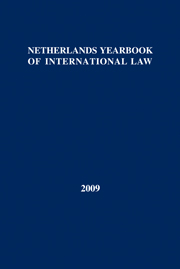No CrossRef data available.
Article contents
Role, consensus and opinion analysis at the International Court of Justice*
Published online by Cambridge University Press: 07 July 2009
Extract
Sociologically oriented studies of courts have been well-established in the United States for many decades. The interest of the American Realist School of Jurisprudence in how courts actually do work, as opposed to how they say they work, has ensured a reception for those studies which might help us better understand judicial behaviour. They have been accepted much more slowly in other jurisdictions such as Germany and the United Kingdom and are yet to be accepted in France. Sociological analyses of court processes and judicial behaviour in international tribunals have also been slow to be accepted. As recently as 1975 an eminent international lawyer found a first attempt at such a study on the International Court of Justice “disconcerting”.
- Type
- Articles
- Information
- Copyright
- Copyright © T.M.C. Asser Press 1983
References
1. Rousseau, C., Review of Prott, Der internationale Richter im Spannungsfeld der Rechtskulturen, 80 Revue Générale de Droit International Public (1975) p. 1214.Google Scholar
2. Stevens, R., Law and Politics: The House of Lords as a Judicial Body 1800–1976 (Weidenfeld and Nicholson, London 1979).Google Scholar
3. See also: Shetreet, S., Judges on Trial (North Holland, Amsterdam 1976).Google Scholar
4. Tay, A.E.–S., “Law, the citizen and the state”, in E. Kamenka et al. Law and Society, (Edward Arnold, Melbourne 1978) p. 1 at pp. 8–9.Google Scholar
5. Franck, T., The Structure of Impartiality (Macmillan, New York 1968).Google Scholar
6. Weber, M., Wirtschaft und Gesellschaft (1922) [Translated by Shils, E. and Rheinstein, M., On Law in Economy and Society] (Harvard University Press, Cambridge U.S.A. 1969).Google Scholar
7. Wang, Gungwu, Power, Rights and Duties in Chinese History (Australian National University Press, Canberra 1979).Google Scholar
8. ICJ Reports (1962) p. 6.
9. ICJ Reports (1966) p. 6.
10. Falk, R., The Southwest Africa Cases, 21 International Organization (1967) p. 1 at p. 14.CrossRefGoogle Scholar
11. J. Tarazi, Aegean Sea (Interim Measures) Case, ICJ Reports (1976) p. 2, Separate Opinion p. 32 at p. 34.
12. Fitzmaurice, G., The Future of Public International Law, Special Report in the Livre du Centenaire 1873–1973 (Institut du Droit International 1973) p. 232 at p. 278 n. 192.Google Scholar
13. Prott, L.V., The Latent Power of Culture and the International Judge (Professional Books, Abingdon 1979)Google Scholar; “The Future of the International Court of Justice”, 33 Yearbook of World Affairs (1979) p. 284 at pp. 297–303.Google Scholar
14. Bellet, P. and Tunc, A., La Cour judicaire suprème: Une Enquête Comparative. (Economica, Paris 1978).Google Scholar
15. Carnegie, A.R., “The Law of the Sea Tribunal”, 28 International and Comparative Law Quarterly (1979) p. 669.CrossRefGoogle Scholar
16. G. Fitzmaurice, op. cit. in n. 12, p. 289.
17. Rules, Art. 95.
18. ICJ Reports (1964) p. 6.
19. ICJ Reports (1969) p. 3.
20. ICJ Reports (1972) p. 16.
21. Statute Art. 1.
22. ICJ Reports (1966) p. 6, Dissenting Opinion p. 323.
23. Lachs, M., “The Revised Procedure of the International Court of Justice”, in Essays on the Development of the International Legal Order in Memory of Panhuys (Sijthoff Noordhoff, The Hague 1980) p. 21.Google Scholar
24. ICJ Reports (1971) p. 16 at p. 31.
25. ICJ Reports (1974) p. 253.
26. ICJ Reports (1980) p. 4.
27. Schubert, G., Quantitative Analysis of Judicial Behavior (Free Press, New York 1959)Google Scholar; Judicial Decision-making (Free Press, New York 1963)Google Scholar; Symposium: Jurimetrics, 28 Law and Contemporary Problems (1963) pp. 1–270Google Scholar; Symposium: Empirical Approaches to Judicial Behaviour, 42 University of Cincinnati Law Review (1978) pp. 589–677.Google Scholar
28. Schubert, loc. cit.
29. A. Blackshield, “X/Y/Z/N Scales: The High Court of Australia 1972–1976”, in Tomasic, R.Understanding Lawyers. The Law Foundation of New South Wales. (George Allen & Unwin, Sydney 1978) pp. 133–177.Google Scholar
30. Blackshield loc. cit.
31. Blackshield loc. cit.
32. I have included in these figures Orders for Interim Measures of Protection but not of other Orders where individual voting has not usually been available.
33. ICJ Reports (1974) p. 3.
34. ICJ Reports (1974) p. 175.
35. ICJ Reports (1974) p. 254.
36. Blackshield supra.
37. Schubert Quantitative Analysis, p. 20, loc.cit.
38. Blackshield, A., Quantitative Analysis: The High Court of Australia 1964–1969. 3 Lawasia (1972) pp. 32–29.Google Scholar
39. Blackshield supra n. 29 p. 138.
40. Spender and Fitzmaurice JJ., ICJ Reports (1962) p. 319 Joint Dissenting Opinion pp. 416–417.
41. Merrills, I.S., Images and Models in the World Court: The Individual Opinions in the North Sea Continental Shelf Cases, 41 Modern Law Review (1978) pp. 638–659.CrossRefGoogle Scholar
42. Merrills' (1964, 65ff.) use of “normative” and “policy-oriented” descriptions of the two “models” of international law roughly corresponds to this division and Blackshicld's (1978, 135) use of the term “legalist” would seem to relate closely to the “normative” – “judicial conservative” polarity.
43. ICJ Reports (1970) p. 3.
44. ICJ Reports (1970) p. 4, Separate Opinion p. 244 at p. 248.
45. ICJ Reports (1970) p. 3, Separate Opinion pp. 127, 130.
46. Advisory Opinion on Reparation for Injuries Suffered in the Service of the UN, ICJ Reports (1949) at p. 174, Separate Opinion p. 190.
47. ICJ Reports (1949) p. 174, Dissenting Opinion p. 217 at p. 219.
48. ICJ Reports (1966), Dissenting Opinion p. 250 at p. 276; cf., Jessup, Dissenting Opinion p. 325 at p. 353.
49. ICJ Reports (1962) p. 319, Joint Dissenting Opinion p. 465 at p. 468.
50. Case last cited, Dissenting Opinion of Wellington Koo J., p. 75 esp. at pp. 90–91; Judgment p. 6 at p. 32.
51. ICJ Reports (1974) p. 26, Separate Opinion.


